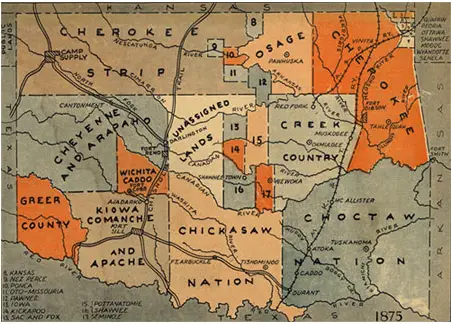The Oklahoma Land Rush
Forced relocation of Native Americans was not an uncommon occurrence in the early 19th Century. One of the prime destinations for the relocated people was the Indian Territory, in what is now Oklahoma. By the 1880s, the U.S. Government had decided to open Indian Territory to white settlement.
Leading the charge of settlement into the Unassigned Lands was Civil War veteran David Payne. The former Kansas state representative led several colonizing expeditions into the Unassigned Lands, even standing trial and accepting a monetary fine for trespassing on what was then still Native American-owned land. At this time, the term "Boomer" came into existence. Used by Dr. Morrison Munford of the Kansas City Times, the term referred to people who were agitating to get into what became the Oklahoma Territory, anticipating the land boom that followed. Payne was seen as the leader of the Boomer movement. He died in 1884. Also contributing to the growing interest in the settlement of Indian Territory was Elias Boudinot, a member of the Cherokee tribe who was a lobbyist in the nation's capital and who published an article about the issue in the Chicago Times in 1879. Boudinot's article was republished throughout the country, and interest in the Oklahoma land issue spread nationwide. The Indian Appropriations Act of 1889 opened Indian Territory to white settlement. President Benjamin Harrison set a date of opening for April 22.
Some had sneaked in early; their wanting to be in place sooner than others led to the designation of "Sooner," a term still used in Oklahoma today (most notably as the mascot for one of the state universities). The Sooners' activities led to many lawsuits, which were handled initially by local land offices but then by the Department of the Interior. Many sources say that the cities of Guthrie and Oklahoma City sprung up on that very day, swelling to 10,000 people before nightfall. The following year, the Oklahoma Organic Act established the Oklahoma Territory, with Guthrie as the territorial capital. Oklahoma became a state in 1907. |
|
Social Studies for Kids
copyright 2002–2024
David White



 Native American tribes–among them Apache, Cherokee, Cheyenne, Chickasaw, Commanche, and Creek–had been forced by the
Native American tribes–among them Apache, Cherokee, Cheyenne, Chickasaw, Commanche, and Creek–had been forced by the  At noon on that day, tens of thousands of would-be settlers rushed into what they hoped was their new home lands. Some went immediately to work, carving out boundaries and setting up the trappings of new towns.
At noon on that day, tens of thousands of would-be settlers rushed into what they hoped was their new home lands. Some went immediately to work, carving out boundaries and setting up the trappings of new towns.
